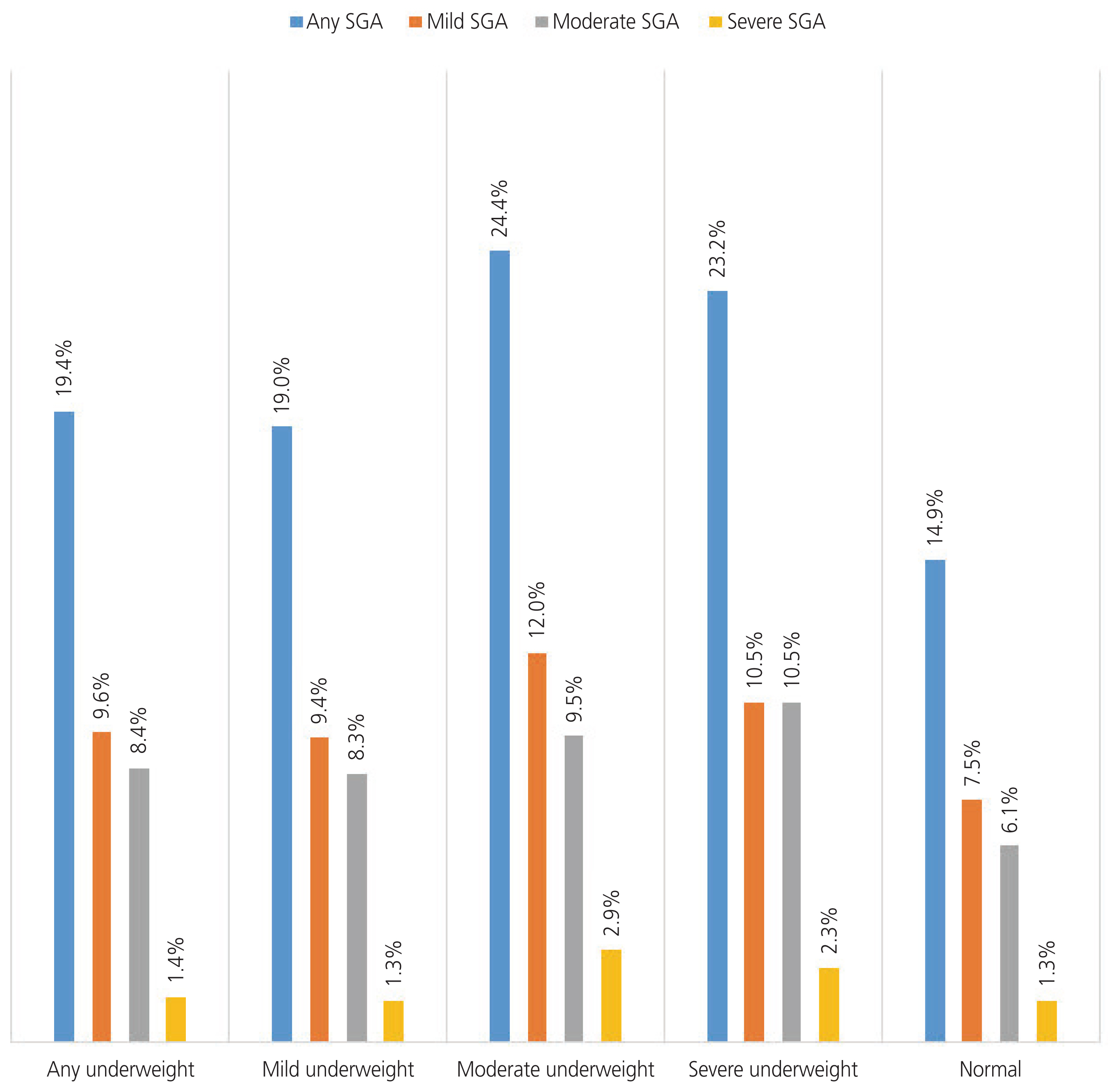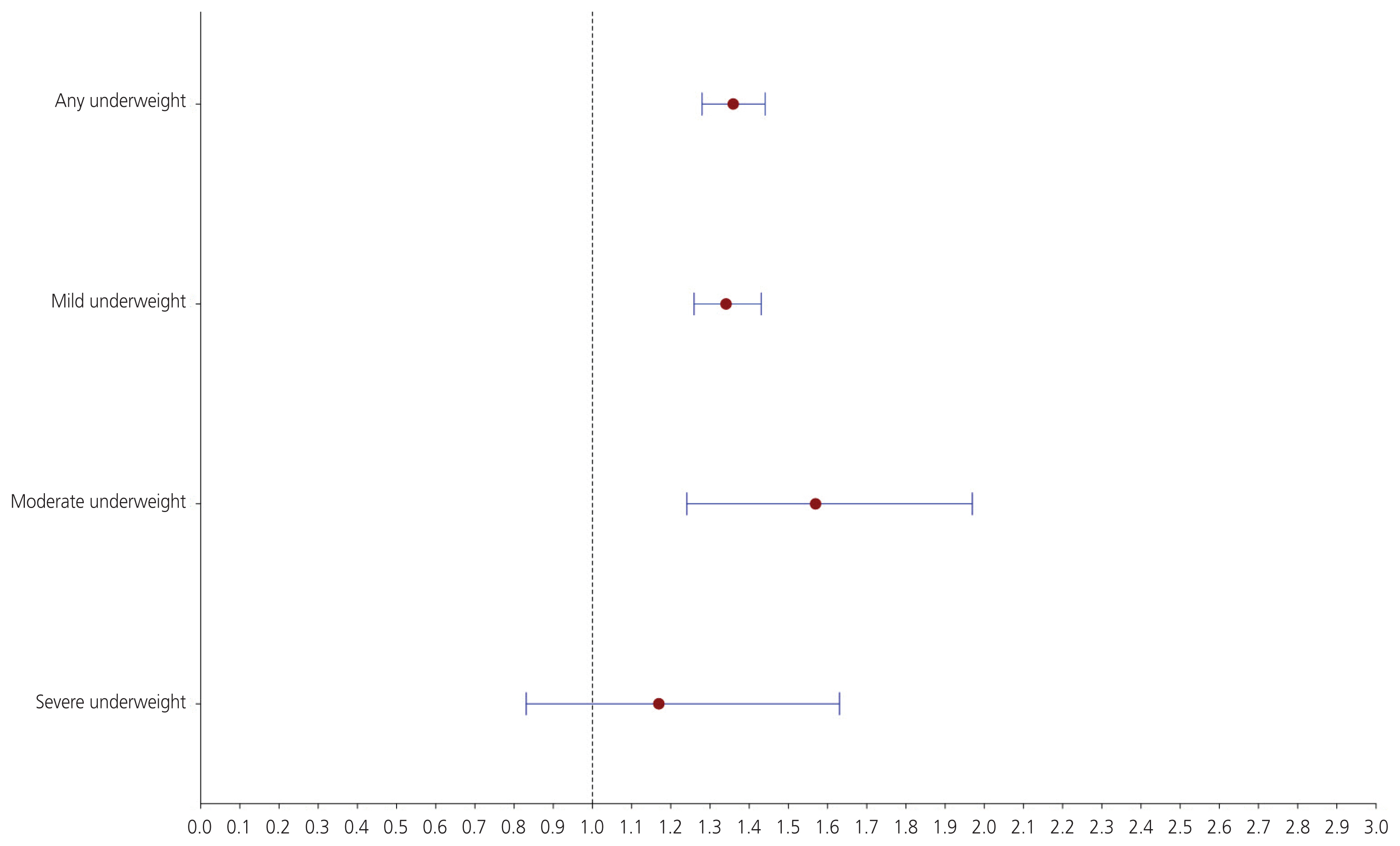Obstet Gynecol Sci.
2021 Nov;64(6):496-505. 10.5468/ogs.21243.
Maternal pre-pregnancy underweight and the risk of small-for-gestational-age in Asian-American ethnic groups
- Affiliations
-
- 1Center of Excellence in Health Equity, Training, and Research, Baylor College of Medicine, Houston, TX, USA
- 2Department of Family Medicine, Baylor College of Medicine, Houston, TX, USA
- 3Department of Pediatrics, Texas Tech University Health Sciences Center, El Paso, TX, USA
- 4College of Nursing & Public Health, Adelphi University, Garden City, NY, USA
- 5Department of Dental Public Health, Faculty of Dentistry, King Abdulaziz University, Jeddah, Saudi Arabia
- KMID: 2522473
- DOI: http://doi.org/10.5468/ogs.21243
Abstract
Objective
This study aimed to examine the association between maternal pre-pregnancy underweight and the risk of small-forgestational-age (SGA) birth among Asian Americans compared with non-Hispanic (NH) whites.
Methods
Using 2014-2018 birth data, we categorized maternal underweight and SGA according to severity. Bivariate analyses were performed to examine the demographics and maternal body mass index (BMI). Adjusted logistic regression models were used to analyze the association between maternal BMI and SGA among Asian Americans compared with NH-Whites.
Results
In Asian Americans, the likelihood of SGA birth was higher among underweight mothers than among mothers with a normal BMI (odds ratio [OR], 1.37; 95% confidence interval [CI], 1.30-1.46). We observed that as the severity of maternal underweight increased, the adjusted odds of SGA increased. Underweight Asian American mothers were more likely to give birth to SGA infants than underweight NH-White mothers (OR, 1.36; 95% CI, 1.28-1.44).
Conclusion
This study shows the association between maternal underweight and SGA birth among Asian Americans, supporting the development of culture-sensitive interventions addressing the impact of weight on pregnancy.
Figure
Cited by 2 articles
-
Preeclampsia and aspirin
Tae Gyu Ahn, Jong Yun Hwang
Obstet Gynecol Sci. 2023;66(3):120-132. doi: 10.5468/ogs.22261.Trends, statistics, and policy recommendations on maternal, fetal, and infant mortality before and after COVID-19: a review of the past decade (2012-2022) based on national health information data
Kyung Ju Lee, Seokmin Lee
Obstet Gynecol Sci. 2025;68(1):59-68. doi: 10.5468/ogs.24264.
Reference
-
References
1. Lauderdale DS, Rathouz PJ. Body mass index in a US national sample of Asian Americans: effects of nativity, years since immigration and socioeconomic status. Int J Obes Relat Metab Disord. 2000; 24:1188–94.
Article2. Singh GK, DiBari JN. Marked disparities in pre-pregnancy obesity and overweight prevalence among US Women by race/ethnicity, nativity/immigrant status, and sociodemographic characteristics, 2012–2014. J Obes. 2019; 2019:2419263.
Article3. Barnes PM, Adams PF, Powell-Griner E. Health characteristics of the Asian adult population: United States, 2004–2006. Adv Data. 2008; 394:1–22.
Article4. Dongarwar D, Tahseen D, Wang L, Aliyu MH, Salihu HM. Trends and predictors of preterm birth among Asian Americans by ethnicity, 1992–2018. J Matern Fetal Neonatal Med. 2021; Mar. 11. [Epub]. https://doi.org/10.1080/14767058.2021.1900103 .
Article5. Dongarwar D, Tahseen D, Aliyu MH, Salihu HM. Pregnancy outcomes among Asian Americans of advanced maternal age, 1992–2018. J Obstet Gynaecol Res. 2021; 47:2117–25.
Article6. Lee KJ, Sohn S, Hong K, Kim J, Kim R, Lee S, et al. Maternal, infant, and perinatal mortality statistics and trends in Korea between 2009 and 2017. Obstet Gynecol Sci. 2020; 63:623–30.
Article7. Watanabe H, Inoue K, Doi M, Matsumoto M, Ogasawara K, Fukuoka H, et al. Risk factors for term small for gestational age infants in women with low pre-pregnancy body mass index. J Obstet Gynaecol Res. 2010; 36:506–12.
Article8. Liu L, Ma Y, Wang N, Lin W, Liu Y, Wen D. Maternal body mass index and risk of neonatal adverse outcomes in China: a systematic review and meta-analysis. BMC Pregnancy Childbirth. 2019; 19:105.
Article9. Neggers Y, Goldenberg RL. Some thoughts on body mass index, micronutrient intakes and pregnancy outcome. J Nutr. 2003; 133(5 Suppl 2):1737S–40.
Article10. Liu P, Xu L, Wang Y, Zhang Y, Du Y, Sun Y, et al. Association between perinatal outcomes and maternal pre-pregnancy body mass index. Obes Rev. 2016; 17:1091–102.
Article11. Kim HY, Lee D, Kim J, Noh E, Ahn KH, Hong SC, et al. Secular trends in cesarean sections and risk factors in South Korea (2006–2015). Obstet Gynecol Sci. 2020; 63:440–7.
Article12. Triunfo S, Lanzone A. Impact of maternal under nutrition on obstetric outcomes. J Endocrinol Invest. 2015; 38:31–8.
Article13. Sekiya N, Anai T, Matsubara M, Miyazaki F. Maternal weight gain rate in the second trimester are associated with birth weight and length of gestation. Gynecol Obstet Invest. 2007; 63:45–8.
Article14. Ehrenberg HM, Dierker L, Milluzzi C, Mercer BM. Low maternal weight, failure to thrive in pregnancy, and adverse pregnancy outcomes. Am J Obstet Gynecol. 2003; 189:1726–30.
Article15. McMillen IC, Adam CL, Mühlhäusler BS. Early origins of obesity: programming the appetite regulatory system. J Physiol. 2005; 565(Pt 1):9–17.
Article16. Goldstein RF, Abell SK, Ranasinha S, Misso M, Boyle JA, Black MH, et al. Association of gestational weight gain with maternal and infant outcomes: a systematic review and meta-analysis. JAMA. 2017; 317:2207–25.
Article17. Arora P, Tamber Aeri B. Gestational weight gain among healthy pregnant women from Asia in comparison with Institute of Medicine (IOM) guidelines-2009: a systematic review. J Pregnancy. 2019; 2019:3849596.
Article18. Choi SK, Park IY, Shin JC. The effects of pre-pregnancy body mass index and gestational weight gain on perinatal outcomes in Korean women: a retrospective cohort study. Reprod Biol Endocrinol. 2011; 9:6.
Article19. Centers for Disease Control and Prevention. The National Vital Statistics System-birth data [Internet]. Atlanta (GA): Centers for Disease Control and Prevention;c2021. [cited 2021 Apr 23]. Available from: https://www.cdc.gov/nchs/nvss/births.htm .20. Alexander GR, Himes JH, Kaufman RB, Mor J, Kogan M. A United States national reference for fetal growth. Obstet Gynecol. 1996; 87:163–8.
Article21. Skills You Need Ltd.. BMI-Body Mass Index [Internet]. Lampeter (UK): Skills You Need Ltd;c2021. [cited 2021 Apr 23]. Available from: https://www.skillsyouneed.com/ps/bmi.html .22. Akahoshi E, Arima K, Miura K, Nishimura T, Abe Y, Yamamoto N, et al. Association of maternal pre-pregnancy weight, weight gain during pregnancy, and smoking with small-for-gestational-age infants in Japan. Early Hum Dev. 2016; 92:33–6.
Article23. Xiao L, Ding G, Vinturache A, Xu J, Ding Y, Guo J, et al. Associations of maternal pre-pregnancy body mass index and gestational weight gain with birth outcomes in Shanghai, China. Sci Rep. 2017; 7:41073.
Article24. Zhang B, Yang S, Yang R, Wang J, Liang S, Hu R, et al. Maternal prepregnancy body mass index and small for gestational age births in Chinese women. Paediatr Perinat Epidemiol. 2016; 30:550–4.
Article25. Han Z, Mulla S, Beyene J, Liao G, McDonald SD; Knowledge Synthesis Group. Maternal underweight and the risk of preterm birth and low birth weight: a systematic review and meta-analyses. Int J Epidemiol. 2011; 40:65–101.
Article26. Chen YH, Li L, Chen W, Liu ZB, Ma L, Gao XX, et al. Pre-pregnancy underweight and obesity are positively associated with small-for-gestational-age infants in a Chinese population. Sci Rep. 2019; 9:15544.
Article27. Li N, Liu E, Guo J, Pan L, Li B, Wang P, et al. Maternal prepregnancy body mass index and gestational weight gain on pregnancy outcomes. PLoS One. 2013; 8:e82310.
Article28. Liu Y, Dai W, Dai X, Li Z. Prepregnancy body mass index and gestational weight gain with the outcome of pregnancy: a 13-year study of 292,568 cases in China. Arch Gynecol Obstet. 2012; 286:905–11.
Article29. Ota E, Ganchimeg T, Morisaki N, Vogel JP, Pileggi C, Ortiz-Panozo E, et al. Risk factors and adverse perinatal outcomes among term and preterm infants born small-for-gestational-age: secondary analyses of the WHO multi-country survey on maternal and newborn health. PLoS One. 2014; 9:e105155.
Article30. Guo Y, Miao Q, Huang T, Fell DB, Harvey ALJ, Wen SW, et al. Racial/ethnic variations in gestational weight gain: a population-based study in Ontario. Can J Public Health. 2019; 110:657–67.
Article31. Lowensohn RI, Stadler DD, Naze C. Current concepts of maternal nutrition. Obstet Gynecol Surv. 2016; 71:413–26.
Article
- Full Text Links
- Actions
-
Cited
- CITED
-
- Close
- Share
- Similar articles
-
- Influence of Pre-Pregnancy Underweight Body Mass Index on Fetal Abdominal Circumference, Estimated Weight, and Pregnancy Outcomes in Gestational Diabetes Mellitus
- Determinants of Infant Birthweight
- The Effect of Maternal Pre-pregnancy Body Mass Index on Very Low Birth Weight Infants
- Factors Influencing on Perinatal Outcomes of Asian Marriage Immigrant Women: Ten-year Experience in a Single Center
- Maternal Body Characteristics and Birth weight of Fullterm Infants



